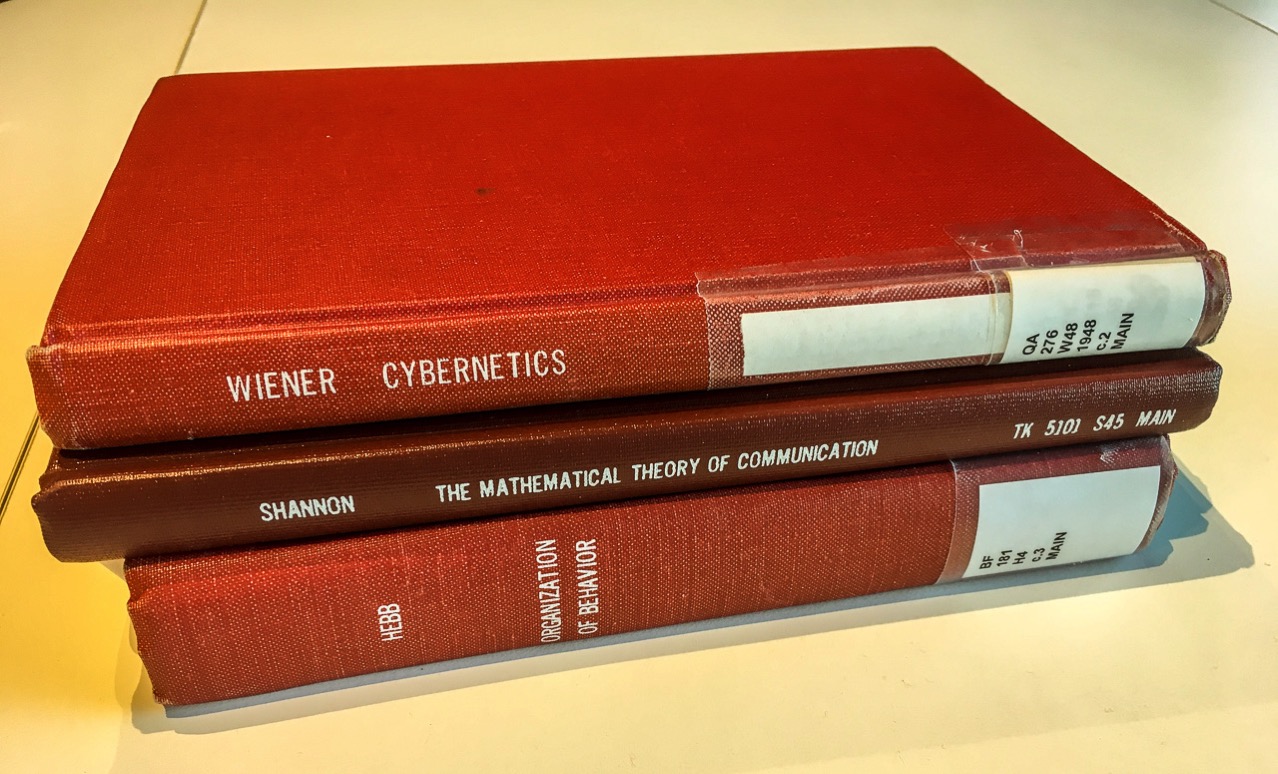Three serious books lie open before me. I had a variety of reasons for checking them out of the library, although they’re all related in one way or another to current goings on here at the Simons Institute:

- Donald O. Hebb’s The Organization of Behavior: A Neuropsychological Theory. This is the book that introduced a fundamental hypothesis about learning and memory, captured in the slogan “Neurons that fire together get wired together.”
- Norbert Wiener’s Cybernetics: or, Control and Communication in the Animal and the Machine, an eccentric and wide-ranging masterpiece with a crucial chapter on “Computing Machines and the Nervous System.”
- Claude Shannon’s The Mathematical Theory of Communication, the foundational document of information theory. (Shannon’s part of this work had appeared a year earlier in the Bell System Technical Journal; the book version includes an interpretive essay by Warren Weaver.)
When I got the three volumes home, I made a surprising discovery: They were all published at roughly the same time, in 1948 and 1949. What are the odds of that? Perhaps it means nothing—just the long arm of coincidence reaching out to tap me on the shoulder. On the other hand, maybe there was something in the air circa 1950, something that made the period unusually fertile for studies of information, communication, and computation in brains and machines.
I have done a little digging in library catalogues and Wikipedia, as well as in my own files, looking for other titles that might belong on this list of distinguished midcentury milestones.
It turns out that George Kingsley Zipf’s Human Behavior and the Principle of Least Effort was also published in 1949. (This is the one about the curious power-law distribution seen in rankings of word frequencies, city sizes, and so on.)
Gilbert Ryle’s The Concept of Mind is another 1949 title, though I’ve never read it. Also from 1949: Nicholas Metropolis and Stanislaw Ulam published the first open account of the Monte Carlo method.
Drifting forward into 1950, we find another cluster of notables. There is John Nash’s one-page paper introducing what we now call the Nash equilibrium. Elsewhere in game theory, 1950 was the debut year for prisoner’s dilemma, although Merrill Flood’s paper describing it did not appear until two years later. Richard Hamming published “Error Detecting and Error Correcting Codes” in 1950. (It’s another paper from the Bell System Technical Journal.) Finally, there’s Alan M. Turing’s famous essay on “Computing Machinery and Intelligence.”
Does the density of high-octane publications really make 1948–50 an exceptional season of intellectual history? I can’t offer any solid statistical support for that notion. In the first place, my criteria for inclusion on the list are way too vague. (“Subjects I find interesting” may be closest to the truth.) In the second place, I can’t offer any evidence that other intervals were not equally productive. As a matter of fact, in my bibliographic rummaging I came across a nexus of brilliance five years earlier:
- Warren S. McCollough and Walter H. Pitts, “A logical calculus of the ideas immanent in nervous activity,” 1943.
- John von Neumann and Oskar Morgenstern, Theory of Games and Economic Behavior, 1944.
- Erwin Schrödinger, What Is Life? The Physical Aspect of the Living Cell, 1944.
- Vannevar Bush, “As We May Think,” 1945.
- John von Neumann, “First Draft of a Report on the EDVAC,” 1945
I acknowledge a further reason for caution when I cite 1949 as a year of special distinction. It’s my year, the year of my birth.

I’m not sure about Hebb and Ryle, but certainly Wiener and Shannon’s work, as well as Zipf’s paper, made a big splash at the time, so not surprising they would stimulate a lot of work, or even feed off one-another, given the relative newness of information theory. Similarly, a few years later (1956) George Miller’s classic paper, “The Magical Number Seven, Plus or Minus Two: Some Limits on our Capacity for Processing Information” appeared and generated a lot more interest (and papers) within psychology.
I suspect any brief time period might show a cluster of scientific work around certain newly-introduced ideas… though whether it is lasting, or a flash-in-the-pan, may vary.
While the sputnik shock was later, and individualists like Shannon possibly did their own thing anytime anyhow, could it be related to the beginning of the cold war, the notion that signal processing in its widest form had enormous impact in World War II, and the anticipation that it will be even more important in the future, that triggered these activities? I think the later Macy conferences focused around cybernetics were clearly related to what now is called military-industrial complex, and endorsed because of their potential importance in getting ahead of the Russian’s in technical terms.
Seems like a group intellectual burst after the end of World War II. Nothing like a war to jiggle one’s thought processes.
To add to the list: The paper that gave “Arrow’s impossibility theorem”
https://www.jstor.org/stable/1828886
Also Edmund Berkeley’s “Giant Brains or Machines that Think”, plus a few others:
http://shape-of-code.coding-guidelines.com/2018/01/12/computer-books-your-great-grandfather-might-have-read/
If you are interested, there is an interesting book about the history of information theory “The Information A History, a Theory, a Flood” by James Gleick that may answer a few of your questions.
Also in 1949, the famous book, Principles of Animal Ecology by Allee, Emerson, Park, Park and Schmidt (the Great AEPPS) was published as was Simpson’s The Meaning of Evolution and Schmalhausen’s Factors of Evolution–all influencing or foundational to ecology and evolution today.